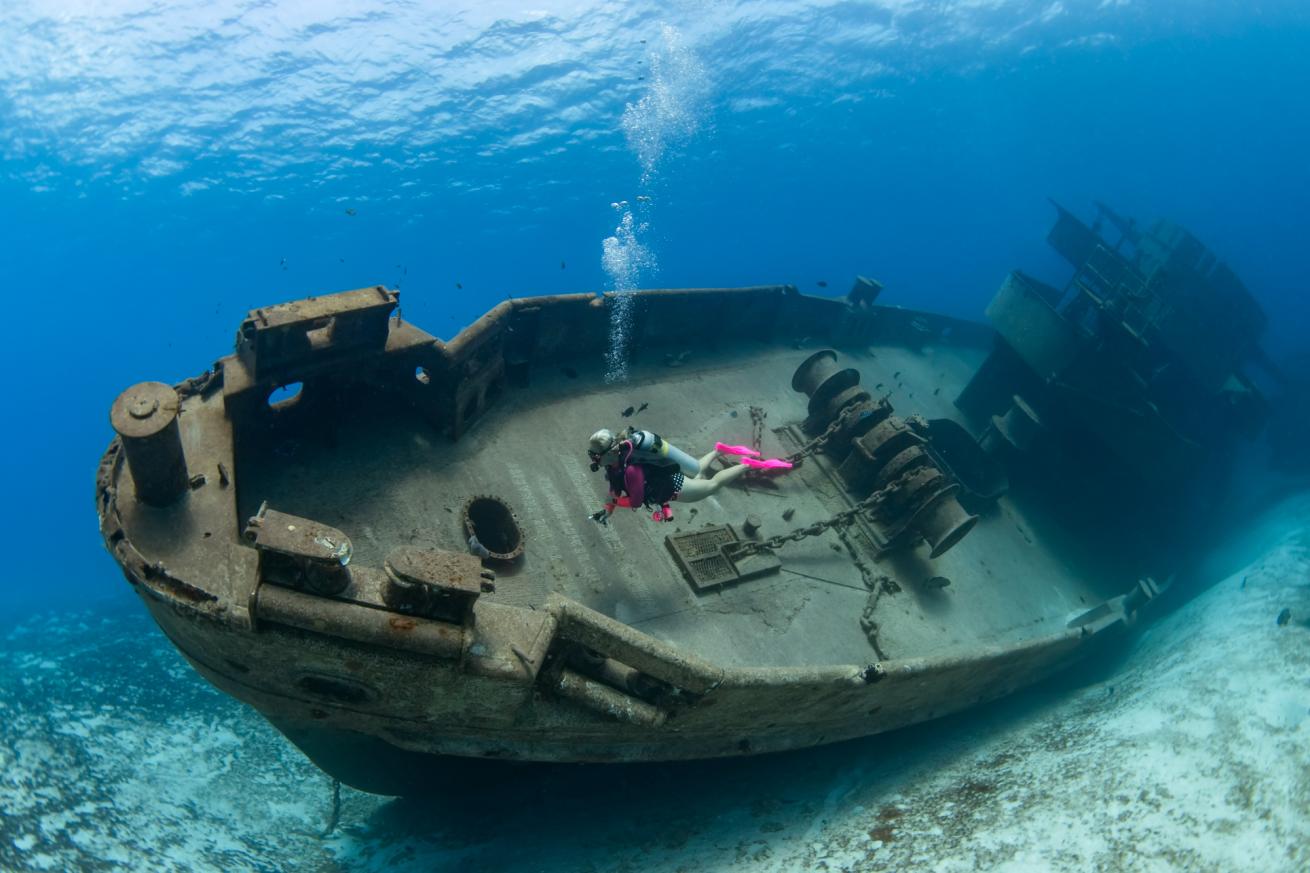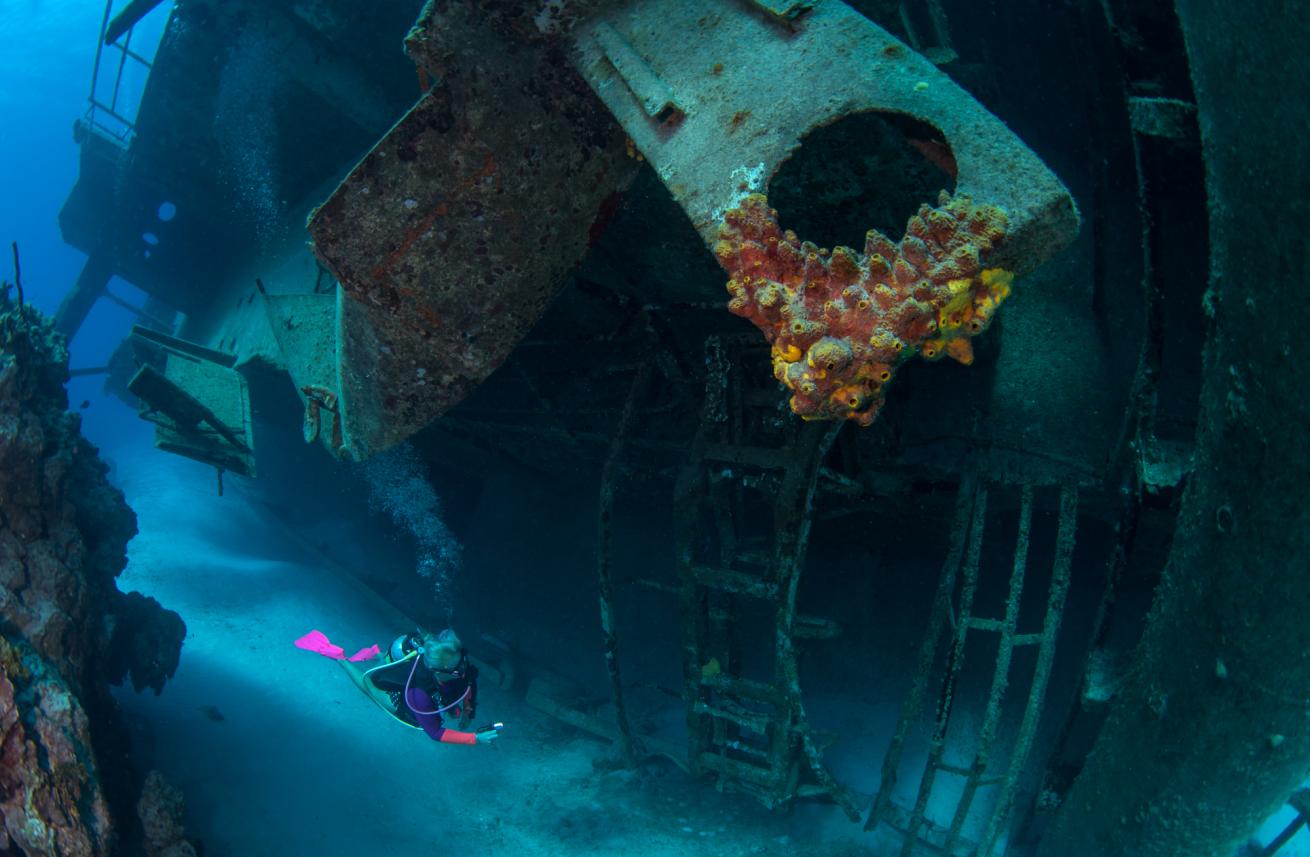Diving the Ex-USS Kittiwake
A mere 800 yards off Grand Cayman’s world-famous Seven Mile Beach lies one of the island’s most iconic and requested dive sites — the wreck of the Ex-USS Kittiwake. The story of just how a U.S. naval vessel came be a much-loved Grand Cayman artificial reef is a fascinating tale.
The Kittiwake was launched in 1945 with divers in mind. That is, would-be Navy divers, as the 251-foot vessel was designed as a submarine support and rescue ship. Accompanying submarines during sea trials, the crew aboard the Kittiwake could monitor dive operations and practice rescue procedures. In its nearly 50-year career, the Kittiwake cruised the Atlantic, Caribbean, Mediterranean and Indian Ocean. Many of its missions are still classified today, but the Kittiwake supported record-breaking dives and rescues and even recovered the black box after the space shuttle Challenger tragedy.
Though the Kittiwake’s first career ended in 1994, the U.S. Maritime Administration has a remarkable program to donate mothballed Navy vessels for use as artificial reefs as long as the proper environmental preparations and safety concerns can be addressed. This is no small feat, but well-known Grand Cayman resident Nancy Easterbrook spearheaded the effort to secure the Kittiwake and undertake the immense preparation involved. The Cayman Islands Tourism Association acquired the ship in 2009, and it took nearly two years to complete the challenging process to sink the ship. Finally, on January 5, 2011, the Kittiwake was successfully placed on the white-sand bottom, close to the shore in 60 feet of crystalline water.

Tanya G. BurnettKittiwake supported record-breaking dives and rescues and even recovered the black box after the space shuttle Challenger tragedy.
The wreck has been an immediate hit from day one, and nearly every dive operator on the island runs trips to this unique dive site. A giant stride into the topaz sea reveals the wreck the moment divers’ bubbles clear. It is rare to experience a wreck of this size in such shallow water, and the often-calm conditions make this a very friendly dive regardless of skill level. Over the years, the occasional passing tropical storm has nudged the vessel toward its port side. Part of the beauty of the Kittiwake is that after almost 13 years on the bottom, it is mature enough to have evolved into an active and thriving reef, but young enough that most of the superstructure is in very good shape, with most features still intact. Because nearly the whole wreck can be seen and navigated from above, it is possible to start exploring almost anywhere.
Many divers head toward the stern, and drop to the sand to the max depth on this site in order to explore and photograph the large bronze propeller. On their descent, divers are often joined by curious great barracuda, while trains of creole wrasse often hug the outline of the structure. The bottom around the prop is frequented by big Southern stingrays that will take off, leaving behind puffs of white sand. Coming up from the prop reveals the lettering of the Kittiwake still visible on the stern. Corals and sponges have populated the railings and superstructure, which means countless small tropicals and reef fish flit about the structure, picking at algae and hiding in sponges. Turtles interrupted from a nap will often swim by, while schools of horse-eye jacks sometimes patrol the decks.
The ship has five different structural levels to explore. The upper three have been opened enough to make them accessible to divers with open water certification. The lower levels require greater penetration and are reserved for those with more advanced training. In either case, there is plenty to see, and the hallways, passages and numerous gas tanks are in remarkable condition. A wary grouper may sometimes be lurking in a cabin, looking for an easy meal. An ironic sighting for many is the distinctive onboard recompression chamber, which is hopefully the only time divers will cross paths with one.

Tanya G. BurnettThis artificial reef located off Seven Mile Beach is the most requested dive site on Grand Cayman.
Before heading back to the surface, take time to check out the intact mast structure in the shallows, which is where some of the most prolific marine-life growth, in a myriad of colors, has taken hold. These masts are truly a separate artificial reef and an underwater beehive of activity. For macro photographers, these shallows can be heaven, with small, jewel-like crustaceans and invertebrates hiding like sparkling gemstones in the lush growth.
Emerging from the upper decks into the bright Grand Cayman sunshine, which illuminates much of the upper part of the wreck, is a joy, and on a calm day, you can roll onto your back while finning and see the clouds in the Caribbean sky. This endless gin-clear water is part of the magic of diving in the Cayman Islands.
Breaking the surface after a long relaxing dive on the Kittiwake, you too will understand why this is the most requested dive in Grand Cayman.
What to Know
Language: English
Currency: Cayman Islands dollar
Signature Dish: Fish rundown, a stew made with coconut-milk-soaked fish.
Signature Topside Activity: Queen Elizabeth II Botanic Park, Grand Cayman; Owen Island, Little Cayman; Bat Cave, Cayman Brac.
Main Airport: Grand Cayman’s Owen Roberts International Airport (GCM).
Water Temp/Visibility: High 70s to low 80s/80 to 100 feet.
Travel Tip: Carry both Cayman and U.S. dollars — resorts and hotels usually quote prices in U.S. dollars, while restaurants and shops ask for Cayman Islands dollars.
Click Here for More Information










